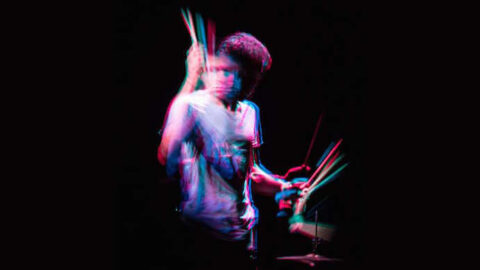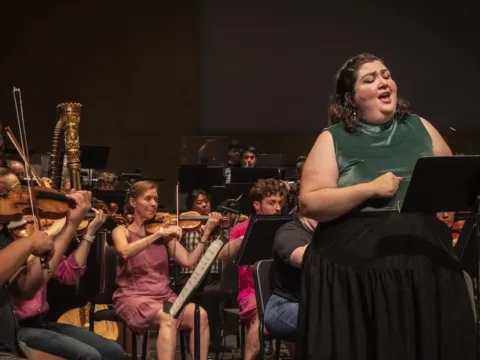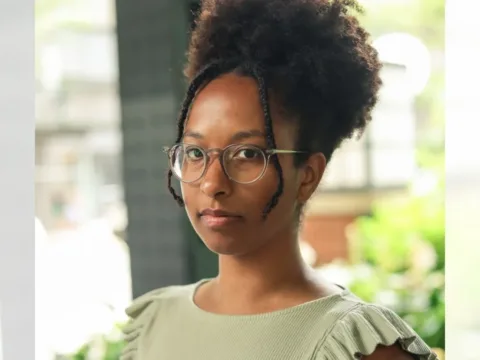Critical composition was the order of the day at the 2017 Donaueschinger Musiktage. This year’s weekend festival in Germany’s Black Forest, October 18-22, played host to a density of societally, politically engaged programming. Festival director Björn Gottstein programmed the four whirlwind days of concerts, talks, and sound-art exhibitions to address a diversity of contemporary political issues, for instance devoting the opening night’s panel discussion to gender imbalance and toxic masculinity in new music institutions; and bringing in composer/musicologist George Lewis to speak about counteracting the continuing prevalence of white, masculinist, and appropriative attitudes in composition today.
Werner Cee’s installation work Sol y sombra was nestled furtively deep in the city park. Across a four-channel speaker array, texts including Swiss chemist Albert Hofmann’s diary notes on his synthesis (and ingestion) of LSD and the hallucinatory nature writings of J. A. Baker and Juna Robin joined recordings of electroacoustic qin (Chinese zither) and guitar. A horn speaker some distance away looped on repeat a 2011 US Army brief on defensive measures for a zombie outbreak. “Zombie-ism” became a term to describe forces of the mindless destruction and obliteration of life and natural resources, in addition to naming the conventional, walking-dead variety. It all amounts to dropping acid during the zombie apocalypse: the ultimate bad trip. Cee recruited the figure of the zombie to betoken the kind of fear that might be adequate to meeting the challenges of the climate crisis.

Thomas Meadowcroft’s The News in Music on the opening orchestral concert staged a collage of schlocky breaking news-style fanfares punctuated by TV news headline announcements. “Channel 4 news, on your side!” “Uncompromising! Factual! Reliable! Authoritative!” Meadowcroft critiques the over relentless news-media bombardment familiar from recent political upheavals like Brexit, or the Trump campaign (“Big and very American!”). Boos and obscenities erupted with the applause. Clearly the musical content was meant to be as revulsive as the condition of contemporary life that it critiques. This was, no doubt, a risky aesthetic choice for Meadowcroft, but an interesting strategy in contrast to less noteworthy program offerings content with clattering away with little to say.
The Kaleidoskop Soloists’ Ensemble staged a remarkable concert for strings called “Transit,” a reflection on the relationship between performers, audiences, and the spaces they move within. The ensemble arrived on a box truck, performing Michael von Biel’s radically terse second string quartet from inside the truckbed, with the door barely cracked. Literally unlike anything heard before its 1963 Darmstadt premiere, its violent scratching and groaning predated Helmut Lachenmann’s similar musique concrète instrumentale aesthetic by years. Fast forward over fifty years: it still possesses an intense energy, erupting like a scream. The ensemble piled out of the truck, instruments in hand like luggage and bundled up for an uninviting winter. Peering dazed around their surroundings as though weary from travel, they gradually lined up like a train of refugees to begin Chiyoko Szlavnics’ Memory Spaces (appearances) and drifted through the ruminative, placid dissonances of her piece. In works by Dmitri Kourliandski (Maps of non-existent cities: Donaueschingen) and Sebastian Claren (Kaleidoskopvillemusik II), the ensemble migrated into the audience space, displacing seated listeners but also inviting us to peer at the scores as they quivered away at impossibly soft harmonics by the close of the concert—a meditation on the question, now relevant to both American and European contexts, of who gets to belong where.

Of course, not every work tackled political matters. The strongest impression was left by Alexander Schubert’s Codec Error, a multimedia spectacle of glitchy electroacoustic pandemonium. A bassist and two percussionists from Ensemble intercontemporain with accompanying electronics bathed the hall in techno-noise, while skittering about onstage under the eerie turquoise strobe lighting, which illuminated the performers strategically to render them into broken, buggy, holographic versions of themselves. The resulting aesthetic of technological failure made it unnervingly difficult to tell whether the bodies onstage were real or somehow projected in video, like human avatars digitally cut and pasted from place to place.
Other highlights included the expansive filigree of New York sound artist Marina Rosenfeld’s large ensemble Deathstar Orchestration, performed with the help of eight guitar amplifier stacks. Misato Mochizuki’s enigmatic Têtes set a series of Japanese ghost stories to musiktheater complete with (fake) severed heads as props for the spoken recitation and a prominent part for the 13-string Japanese koto, refreshingly integrated into the ensemble without exoticisation or overt orientalisms. Bernhard Lang offered a jazz-quintet concerto grosso in his DW 28 ‘Loops for Davis.’ A virtuoso performance from the bass clarinetist at the head of the quintet-ripieno drove the rhythmic verve of the piece through a half hour that rarely got stale, though DW 28 kept to the script of ever-mutating motivic cells featured in Lang’s other Differenz/Wiederholung pieces.
The final performance was of Chaya Czernowin’s Guardian, a concertante work for cello that showcased her inimitable string writing, powerfully and authoritatively performed by long-time collaborator cellist Séverine Ballon. Czernowin writes in the program notes of an intertwining of forces: “the cello is dreaming the orchestra and vice versa,” and Ballon commands massive textures from every part of her instrument with all manner of bowstrokes to mimic the full palette of the SWR orchestra behind her. Guardian was a keynote piece for the festival in many ways: all in all a testament to sheer sonic inventiveness, formal concept, performative prowess, and a powerful rebuke to any lingering doubts as to the credit that female composers and performers deserve—as though to say, “here we are…listen.”

It is notable and laudable that Gottstein gave the festival’s last, gripping word to a female composer—and programmed another female veteran, Bunita Marcus, on the same concert. Yet, the growing awareness of gender imbalance shown by festivals like MaerzMusik, Darmstadt, and Donaueschingen in the past year should by no means beckon self-congratulation. This year, women represented only a third of the concert program, though this certainly improves upon the 2012 Musiktage’s dismal total of one featured female composer. Stickers placed by the activist research group Gender Relations in New Music (grinm.org) read that 92.44% of pieces in Donaueschingen’s history were written by men, a statistic that will by its nature take years of concerted and thoughtful decision-making to balance out. Moreover, with the exceptions of Szlavnics, Mochizuki, and George Lewis, the festival program was racially homogeneous—and socio-economically even more so. What would it take to enact an intersectional feminism in new music? How might festivals acknowledge increasingly widespread discomfort with unbalanced programming to become better mirrors of the world?
























